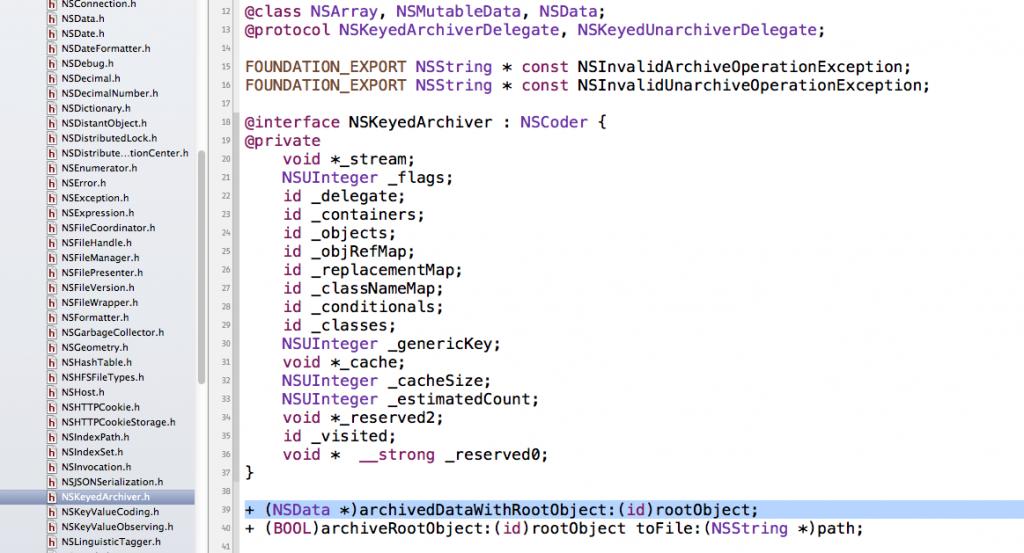本文主要是介绍归档 object-c把数据写入到文件中,希望对大家解决编程问题提供一定的参考价值,需要的开发者们随着小编来一起学习吧!
holydancer原创转自holydancer的CSDN专栏,原文地址:http://blog.csdn.net/holydancer/article/details/7371643
先介绍一个自定义类描述的方法description,一般情况下,一个自定义类我们在用%@输出的时候,给出的是一个内存地址,我们在该类的.m文件里重写description方法,来修改输出内容,呆会儿我们要用到这个方法来验证今天学习内容,所以先看一段代码熟悉一下:
Human.h:
- #import <Foundation/Foundation.h>
- @interface Human : NSObject
- {
- int age;
- NSString *name;
- Human *child;
- }
- @property int age;
- @property (copy)NSString *name;
- @property (retain)Human *child;
- @end
Human.m:
- #import "Human.h"
- @implementation Human
- @synthesize age;
- @synthesize name;
- @synthesize child;
- //-(NSString *)description
- //{
- // NSString *des = [NSString stringWithFormat:@"%d,%@,%@",age,name,child];
- // return des;
- //}
- @end
上面的重写描述被注释掉了,我们先看未修改前的输出:
main.m:
- #import <Foundation/Foundation.h>
- #import "Human.h"
- int main(int argc, const char * argv[])
- {
- @autoreleasepool {
- Human *human1=[[Human alloc]init];
- Human *human2=[[Human alloc]init];
- human1.child=human2;
- human1.name=@"holydancer";
- human1.age=22;
- NSLog(@"%@",human1);
- }
- return 0;
- }
2012-03-20 08:47:32.980 category[304:403] <Human: 0x7ff2cb414380>
如果把human.m中的注释去掉的话输出结果如下:
2012-03-20 08:48:09.869 category[315:403] 22,holydancer,0,(null),(null)
很简单吧,这样就可以查看自己定义类的内容了,好了,下面就让我们来研究一下在objective-c中如何实现序列化。
在OC中,有四类对象是可以直接使用writeToFile方法将内容写入磁盘的,分别是NSString,NSArray,NSDictionary,NSData.看代码:
- #import <Foundation/Foundation.h>
- #import "Human.h"
- int main(int argc, const char * argv[])
- {
- @autoreleasepool {
- NSData *data=[[NSData alloc]init];
- NSString *string=[[NSString alloc]init];
- NSArray *array=[[NSArray alloc]init];
- NSDictionary *dictionary=[[NSDictionary alloc]init];
- [data writeToFile:@"/Users/holydancer/Desktop/text1.txt" atomically:YES];
- [string writeToFile:@"/Users/holydancer/Desktop/text2.txt" atomically:YES];
- [array writeToFile:@"/Users/holydancer/Desktop/text3.txt" atomically:YES];
- [dictionary writeToFile:@"/Users/holydancer/Desktop/text4.txt" atomically:YES];
- //atomically参数是指是否将写入文件的内容开启保护机制,如果开启,会在复制时创建临时文件进行复制,以免写入失败破坏原始文件。安全,但是会消耗内存。
- //上面的文件地址,如果不存在的话会自动生成。有的话会覆盖原有文件内容。
- }
- return 0;
- }

以上四种是COCOA自带可以写入磁盘文件的类型,但是我们常常用到自定义类,可是里面并没有writeToFile方法,怎么办呢?这时NSData的作用就体现出来了,我们可以把任意自定义类转化成NSData格式即可,这个过程我们称之为编码,或者archive归档,需要将自定义类实现NSCoding协议并重写encodeWithCoder和initWithCoder两个方法,分别用以编码和反编码。然后在编码时会用NSCoder的子类NSKeyedArchiver和NSKeyedUnarchiver分别调用archivedDataWithRootObject和unarchiveObjectWithData来启动自定义类中重写的那两个方法,类似于回调。看代码:
Human.h:
- #import <Foundation/Foundation.h>
- @interface Human : NSObject<NSCoding>
- {
- int age;
- NSString *name;
- Human *child;
- }
- @property int age;
- @property (copy)NSString *name;
- @property (retain)Human *child;
- @end
Human.m:
- #import "Human.h"
- @implementation Human
- @synthesize age;
- @synthesize name;
- @synthesize child;
- -(NSString *)description
- {
- NSString *des = [NSString stringWithFormat:@"%d,%@,%@",age,name,child];
- return des;
- }
- -(void)encodeWithCoder:(NSCoder *)aCoder//要一一对应
- {
- [aCoder encodeInt:age forKey:@"age"];
- [aCoder encodeObject:name forKey:@"name"];
- [aCoder encodeObject:child forKey:@"child"];
- }
- -(id)initWithCoder:(NSCoder *)aDecoder//和上面对应
- {
- if (self=[super init]) {
- self.age=[aDecoder decodeIntForKey:@"age"];
- self.name=[aDecoder decodeObjectForKey:@"name"];
- self.child=[aDecoder decodeObjectForKey:@"child"];
- }
- return self;
- }
- @end
main.m:
- #import <Foundation/Foundation.h>
- #import "Human.h"
- #import <Foundation/NSKeyedArchiver.h>
- int main(int argc, const char * argv[])
- {
- @autoreleasepool {
- Human *human1=[[Human alloc]init];
- Human *human2=[[Human alloc]init];
- human1.age=20;
- human1.name=@"holydancer";
- human1.child=human2;
- //定义好自定义对象后使用NSCoding的子类调用archivedDataWithRootObject方法进行archive
- NSData *data1=[NSKeyedArchiver archivedDataWithRootObject:human1];
- //转成NSData类型后就可以写入本地磁盘了
- [data1 writeToFile:@"/Users/holydancer/Desktop/tmp.txt" atomically:YES];
- //倒过来的话先读取磁盘文件
- NSData *data2=[NSData dataWithContentsOfFile:@"/Users/holydancer/Desktop/tmp.txt"];
- Human *human3=[NSKeyedUnarchiver unarchiveObjectWithData:data2];
- NSLog(@"%@,%@",human1,human3);
- }
- return 0;
- }
2012-03-20 10:10:29.871 category[458:403]
20,holydancer,0,(null),(null)
20,holydancer,0,(null),(null)
有的同学一直不太清楚NSKeyedArchiver和NSKeyedUnarchiver是什么,调用的又是什么方法,大家可以在头文件里找到这样的信息: 
可以发现,NSKeyedArchiver是NSCoder的子类,而archivedDataWithRootObject是里面的一个类方法,这时我们看到archivedDataWithRootObject方法下在还有一个方法,不错,这个方法可以直接将自定义类写入本地磁盘,所以上在的代码我们还可以这样写:
- #import <Foundation/Foundation.h>
- #import "Human.h"
- #import <Foundation/NSKeyedArchiver.h>
- int main(int argc, const char * argv[])
- {
- @autoreleasepool {
- Human *human1=[[Human alloc]init];
- Human *human2=[[Human alloc]init];
- human1.age=20;
- human1.name=@"holydancer";
- human1.child=human2;
- [NSKeyedArchiver archiveRootObject:human1 toFile:@"/Users/holydancer/Desktop/tmp.txt"];//直接写入磁盘
- Human *human3=[NSKeyedUnarchiver unarchiveObjectWithFile:@"/Users/holydancer/Desktop/tmp.txt"];//从磁盘直接读取为id类型
- NSLog(@"\n%@\n%@",human1,human3);
- }
- return 0;
- }
2012-03-20 10:16:43.561 category[475:403]
20,holydancer,0,(null),(null)
20,holydancer,0,(null),(null)
最后,不得不说说cocoa中的方法命名,一个一个方法长得,虽然很人性化很好记,不过敲起来真是麻烦啊。
关键字:objective-c ,objective c , oc ,本地化,序列化,归档,archive ,NSCoder ,NSCoding , NSKeyedArchiver ,NSKeyedUnarchiver
这篇关于归档 object-c把数据写入到文件中的文章就介绍到这儿,希望我们推荐的文章对编程师们有所帮助!





